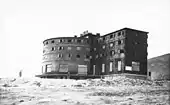Gran Sasso raid
The Gran Sasso raid was the rescue of Italian dictator Benito Mussolini from the Gran Sasso d'Italia massif by German paratroopers and Waffen-SS commandos in September 1943, during World War II. The airborne operation was personally ordered by Adolf Hitler, approved by General Kurt Student, and planned and executed by Major Harald Mors.
| Gran Sasso raid | |
|---|---|
| Part of World War II | |
 Mussolini with German commandos | |
| Type | Rescue mission |
| Location | Hotel Campo Imperatore, Italy |
| Planned by | Harald Mors |
| Target | Campo Imperatore |
| Date | 12 September 1943 |
| Executed by | |
| Outcome | Benito Mussolini rescued |
| Casualties | 2 Italians killed, 10 Germans wounded |
Overview
On the night between 24 and 25 July 1943, a few weeks after the Allied invasion of Sicily and bombing of Rome, the Grand Council of Fascism voted a motion of no confidence against Mussolini. On the same day, the king replaced him with Marshal Pietro Badoglio[1] and had him arrested.[2]
Hitler's common procedure was to give similar orders to competing German military organizations. He ordered the Hauptsturmführer Otto Skorzeny to track Mussolini, and simultaneously ordered the paratroop General Kurt Student to execute the liberation.
Mussolini was being secluded around Tyrrhenian Sea islands by his captors – first to Ponza, then to La Maddalena, where Skorzeny's men were almost attempting an operation. Intercepting a coded Italian radio message, Skorzeny used the reconnaissance provided by the agents and informants (counterfeit notes with a face value of £100,000 forged under Operation Bernhard were used to help obtain information) of SS-Obersturmbannführer Herbert Kappler to determine that Mussolini was being imprisoned in Gran Sasso massif, a remote and defendable mountain plateau, on which was built a hotel linked with a cable car.

On 12 September 1943, Skorzeny and 16 SS troopers joined the Fallschirmjäger to rescue Mussolini in a high-risk glider mission. Ten DFS 230 gliders, each carrying nine soldiers and a pilot, towed by Henschel Hs 126 planes started between 13:05 and 13:10 from the Pratica di Mare Air Base near Rome.
The leader of the airborne operation, paratrooper-Oberleutnant Georg Freiherr von Berlepsch, entered the first glider, while Skorzeny and his SS troopers sat in the fourth and fifth glider. To gain height before crossing the close by Alban Hills, the leading three glider-towing plane units flew an additional loop. All following units considered this manoeuvre unnecessary and preferred not to endanger the given time of arrival at the target. This led to the situation that Skorzeny's two units arrived first over the target.[3]
Meanwhile, the valley station of the funicular railway leading to the Campo Imperatore was captured at 14:00 in a ground attack by two paratrooper companies led by Major Harald Mors, who was commander-in-chief of the whole raid. They also cut all telephone lines. At 14:05, the airborne commandos landed their ten DFS 230 gliders on the mountain near the hotel; one crashed, causing injuries.

The Fallschirmjäger and Skorzeny's special troopers overwhelmed Mussolini's captors—200 well-equipped Carabinieri guards—without a single shot being fired; this was also due to the fact that General Fernando Soleti of the Italian African Police, who flew in with Skorzeny, told them to stand down. Skorzeny attacked the radio operator and his equipment and stormed into the hotel, followed by his SS troopers and the paratroopers. Ten minutes after the beginning of the raid, Mussolini left the hotel, accompanied by the German soldiers. At 14:45, Major Mors accessed the Hotel via the funicular railway and introduced himself to Mussolini.
Subsequently, Mussolini was to be flown out by a Fieseler Fi 156 STOL plane that had arrived in the meantime. Although under the given circumstances the small plane was overloaded, Skorzeny insisted on accompanying Mussolini, thus endangering the success of the mission. After an extremely dangerous but successful take-off, they flew to Pratica di Mare. There they continued immediately, flying in a Heinkel He 111 to Vienna, where Mussolini stayed overnight at the Hotel Imperial. The next day he was flown to Munich and on 14 September, he met Hitler at Führer Headquarters Wolf's Lair in near Rastenburg.[4]
Aftermath

The operation granted a rare late-war public relations opportunity to Hermann Göring, with German propaganda hailing the operation for months afterward. The landing at Campo Imperatore was in fact led by First Lieutenant von Berlepsch, commanded by Major Mors and under orders from General Student, all Fallschirmjäger officers; but Skorzeny stewarded the Italian leader right in front of the cameras.
After a pro-SS propaganda coup at the behest of Reichsführer-SS Heinrich Himmler and propaganda minister Joseph Goebbels, Skorzeny and his special forces of the Waffen-SS were granted the majority of the credit for the operation. Skorzeny gained a large amount of success from this mission; he received a promotion to Sturmbannführer, the award of the Knight's Cross of the Iron Cross and fame that led to his "most dangerous man in Europe" image.[3]
Winston Churchill himself described the mission as "one of great daring".
See also
Footnotes
- Whittam, John (2005). Fascist Italy. Manchester University Press. ISBN 0-7190-4004-3.
- Annussek, Greg (2005). Hitler's Raid to Save Mussolini. Da Capo Press. ISBN 978-0-306-81396-2.
- Óscar González López (2007). Fallschirmjäger at the Gran Sasso. Valladolid: AF Editores. ISBN 978-84-96935-00-6.
- Erich Kuby: Verrat auf deutsch. Wie das Dritte Reich Italien ruinierte. Hoffmann und Campe, Hamburg 1982, ISBN 3-455-08754-X.
External links
 Media related to Gran Sasso raid at Wikimedia Commons
Media related to Gran Sasso raid at Wikimedia Commons